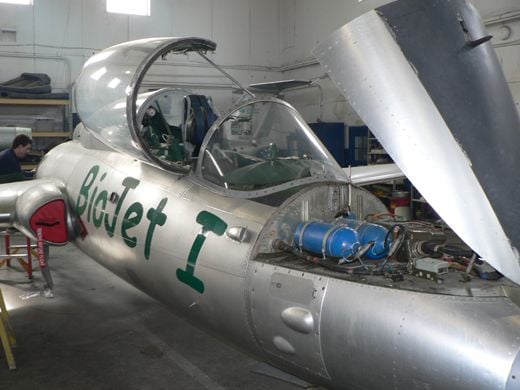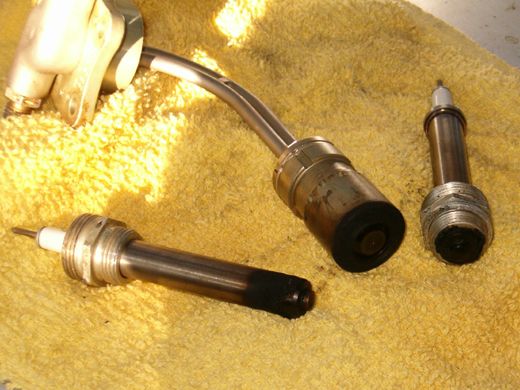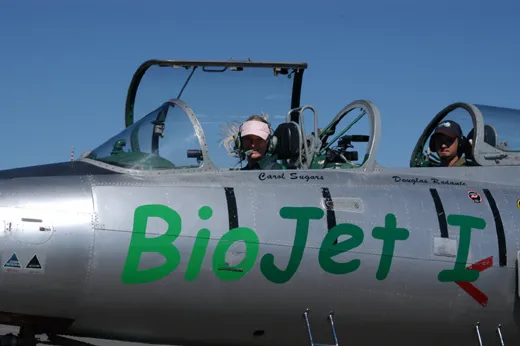Fly Canola!
Doug Rodante plans to fly his L-29 cross-country using cooking oil for fuel.
/https://tf-cmsv2-smithsonianmag-media.s3.amazonaws.com/filer/biofuel-main-388.jpg)
Call it the greening of aviation.
On Sunday a Boeing 747-400 became the first commercial airliner to flight-test an eco-friendly biofuel, just weeks after an Airbus jumbo A380 made the three-hour Boeing and Air New Zealand have announced plans for a biofuel demonstration flight on a B747-400 in the second half of this year.
And if Doug Rodante can solve his soot problems, he’ll fly from Reno to Florida this May on a tank of canola oil. His Czech-made Aero L-29 Delfin training jet, a relic of the Soviet era, can stomach nearly any gas cocktail brewed at a Cold War airfield. Rodante and his chief pilot at Carol Sugars, have tanked up the L-29 with blends of conventional jet fuel and a variety of oils, from restaurant waste to home heating oil.
"We started with 100 percent jet fuel and marked the time-to-altitude and the EGT [exhaust gas temperature, an indicator of how efficiently the fuel is combusting]," says Rodante. "Then we went to 25 percent [biofuel], 50 percent, and 100 percent." In October, Rodante and Sugars flew the Delfin for 34 minutes, to an altitude of 17,000 feet, on pure biofuel—the first such flight for a jet aircraft. "At 50 percent it ran just like at 100 percent jet fuel," says Rodante. "But when we went to 100 percent biodiesel we got all sorts of soot."
Because the biofuel combusts unevenly, it leaves a residue of black soot from the unburned fuel. The L-29 is now in Reno, Nevada, as Rodante works to fine-tune his fuel mix and recertify the jet for a cross-country attempt in May. The Federal Aviation Administration would have to approve the flight, because certification is specific to a particular type of fuel used with a particular engine. Rodante hopes to gas up with virgin canola for the cross-country trip. If successful, Green Flight International plans to fly a Learjet around the world on biofuel next year.
Virgin Atlantic’s demonstration flight from London Heathrow to Amsterdam’s Schipol Airport, with five people on board, lasted 40 minutes, according to a company press release. The 747’s General Electric CF6 engines burned a mix of 80 percent conventional jet fuel and 20 percent biofuel made of babassu oil and coconut oil, which are commonly used in cosmetic products. Virgin Atlantic, which has made a public campaign of developing green aviation fuels, says that it will reject any raw material that competes with land devoted to food or fresh water.
Environmental groups generally favor creating synthetic fuel from industrial trash or biomass, rather than from carbon-based materials such as coal, tar sands and oil shale. Green Flight’s sponsors, Biodiesel Solutions of Sparks, Nevada, and Renewal Fuels, make renewable fuels and energy from non-food based technology.
For now, with their L-29 in pieces in a Reno hangar, Green Flight’s challenge is to convince the FAA that its original certification can extend to the use of canola oil. "We didn’t think there was a problem with FAA since the jet was rated to run on diesel—basically heating oil," says Rodante. "In our mind that would be the same as biodiesel. We didn’t make any of this a secret. But the FAA wanted to ensure that all bases were covered."
The company had to prove that the fuel won’t gel in colder temperatures, which it did by documenting the fuel temperatures at all altitudes during the earlier test flights. "The Feds are only going to let us fly within a range of temperature and altitude where the fuel won’t gel, even though we have heaters on," says Rodante.
"As you ascend, the temperature drops two to three degrees for every 1,000 feet higher, and that’s why no one has used biofuels in jets. But this jet was designed in Czechoslovakia as a trainer for MiGs. They made it work with JP-4 [jet fuel] and kerosene, and put in fuel filters and equipped the system with heaters, so we didn’t have a problem with fuel gelling in this aircraft," says Rodante.
In the L-29, fuel is stored behind the cockpit seats rather than in the wings. "With fuel behind the canopies where the pilot sits, it stays at a more or less constant temperature," Rodante says. He plans to use this same fuel storage strategy for the Learjet flight in 2009.
One of Rodante’s chief advisers is Institute For Air Science at Baylor University, whose ethanol-fueled Pitts S-2B Velocity will be donated to the National Air and Space Museum. Ethanol’s virtue as an environmentally friendly fuel Tim Searchinger, whose data suggest that the clearing of forest land to grow crops for ethanol could erase any benefits from reduced greenhouse gas emissions.
But airplane operators and manufacturers—both civilian and military—will keep up the search for cheaper and cleaner fuels. The U.S. Air Force is the largest consumer of energy in the federal government, spending $6.6 billion on aviation fuel in 2006, the latest year for which figures are available. Last March, Air Force Secretary Michael Wynne told the Air Force Energy Forum that each increase of $10 in the cost of a barrel of oil costs the Air Force another $600 million per year.
On Dec. 17, on the 104th anniversary of the Wright brothers' first powered flight, the U.S. Air Force flew a C-17 Globemaster III transport aircraft across the country powered on a mix of 50 percent jet fuel and 50 percent synthetic fuel derived from coal. In September of 2006, a B-52H Stratofortress made a similar flight on the same fuel. The Air Force has set a goal to certify its entire fleet to fly on the blend by 2010.


